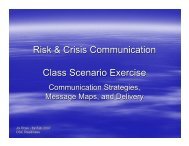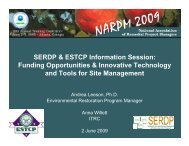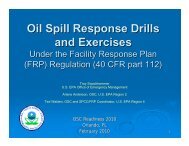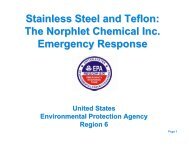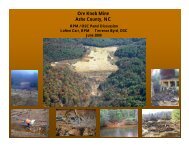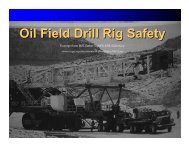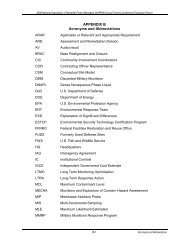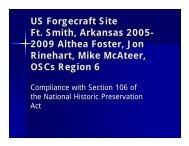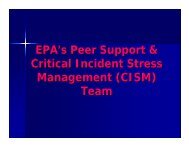OSC 2007 Evaluation Report
OSC 2007 Evaluation Report
OSC 2007 Evaluation Report
You also want an ePaper? Increase the reach of your titles
YUMPU automatically turns print PDFs into web optimized ePapers that Google loves.
<strong>2007</strong> <strong>OSC</strong> Readiness Training Program <strong>Evaluation</strong> <strong>Report</strong><br />
• More strongly consider federal initiatives related to my job.<br />
• Network more locally.<br />
• Network more within my region.<br />
• Networking has improved.<br />
• New effort in radiation coordination.<br />
• No change.<br />
• Organize necessary items for a deployment (certificates, computer stuff, etc.).<br />
• Partnership with other agencies.<br />
• Pay more attention to the NRP revision process!!!<br />
• Place more emphasis on ERRS Daily Work Orders.<br />
• Play with the HAZCAT tools more.<br />
• Possible creation of new fact sheets on technical issues.<br />
• Prepare more thoroughly on chemical detection equipment.<br />
• Prepare sample plans that more accurately represent the site.<br />
• Promote the RSC.<br />
• Provide information to people I networked with at the training.<br />
• Pursue a broader audience for my Web site on bioremediation.<br />
• Pursue enforcement cases more knowledgably.<br />
• Pursue more cross-program training opportunities.<br />
• Push for more regular field work with <strong>OSC</strong>s for the NDT, not just WMD stuff.<br />
• Read the available papers on meth health risk based data.<br />
• Remember the need for ecologically restoring a site.<br />
• Review some of our SPCC issues.<br />
• Risk communications.<br />
• Share materials/course references with colleagues not here, including local responders.<br />
• Since I am not an <strong>OSC</strong>, I now have a greater knowledge of the emergency response program and<br />
nationally how it all works.<br />
• Stay in contact with the U.S. Department of Agriculture (USDA) representative.<br />
• Strive to improve turn around time within other divisions in support of EPA.<br />
• Study the manuals more diligently and frequently.<br />
• Technology integration.<br />
• These contacts will help me do my job more effectively.<br />
• Think about communicating risk.<br />
• Train for certain Web tools showcased at the conference.<br />
• Try to interact more with other resources within EPA.<br />
• Use information obtained from case studies to assist in managing my removal actions.<br />
• Use information on monitoring equipment to ensure my readiness in my region.<br />
• Use Region 2 site file management system.<br />
• Use resources at ERT, even if only via phone call.<br />
• Utilize information learned regarding vapor intrusion.<br />
• Utilize RAT in a hot zone entry.<br />
• Utilize newer internet support tools and databases.<br />
B-16 Comments about the Training Program



